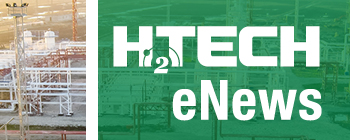News
Idaho National Laboratory tests FuelCell Energy’s electrolyzer to show further commercialization opportunity for nuclear power plants
FuelCell Energy announced that its solid oxide electrolysis cell (SOEC) system has begun a testing and validation period at the U.S. Department of Energy’s Idaho National Laboratory (INL), which focuses on innovations in nuclear research, renewable energy systems and security solutions.
The project, funded partially by a 2020 U.S. Department of Energy Office of Nuclear Energy award, will study how H2 production operations can help nuclear plants diversify and increase their profitability by switching between electricity production and H2 generation. The testing will also look at the potential of advanced small modular reactor designs (200 MW─500 MW in size) paired with FuelCell Energy’s SOEC utility scale electrolzyers.
The testing involves the largest electrolyzer to be studied at INL, and it is expected to show that the technology can reduce the cost of clean H2 production by converting 100% of the electricity and water fed into the system into zero carbon H2. Additionally, the FuelCell Energy electrolyzer:
- Will produce 150 kg/d of H2
- From 250 kilowatts of nuclear energy-generated electricity
- Simulating the benefits of 100% efficiency when waste heat from the nuclear power plant is used.
Unlike past testing INL has conducted on electrolysis “stacks,” the FuelCell Energy electrolyzer being studied is a fully integrated solid oxide electrolyzer system.
FuelCell Energy President and CEO Jason Few commented, “Pairing FuelCell Energy’s electrolyzer with nuclear plants is an excellent example of the ‘all-of-the-above' energy strategy that is necessary to meet the needs of a strained electric infrastructure.”
“Nuclear energy is a baseload power source that when paired with FuelCell Energy’s electrolyzer can ensure that every kilowatt of power is converted into a usable or stored energy resource. FuelCell Energy's electrolysis platform can enable 100% smart energy utilization.”
An electrolyzer is a system that performs electrolysis, which is the process of using electricity to split water molecules (H2O) into H2 and oxygen (O2). H2 produced from electrolysis can be stored long term and transported, allowing energy from wind, solar and nuclear to be available on demand.
FuelCell Energy’s electrolyzer takes in cold water and electricity and then converts it into H2. And when an external source of heat is added, such as heat from a nuclear power plant, the FuelCell Energy electrolyzer can reach 100% efficiency. At this level, the cost of H2 can be reduced by as much as 30%, alleviating cost as a barrier to wider adoption of H2 as an energy source.
The INL testing will study real world use cases that incorporate the application of thermal energy from a nuclear reactor, grid dynamics and a nuclear reactor control simulator.
Few concluded, “Energy innovation that drives down costs, emissions, and leverages all the above energy sources we have today is smart energy and a win-win. We look forward to the progress of this testing, which we believe can positively contribute to the ongoing development of nuclear and fuel cell H2 technologies to create more abundant energy.”
Despite its capacity, the FuelCell Energy electrolyzer occupies a small footprint with a modular design and was shipped to INL from FuelCell Energy’s headquarters in Connecticut on two flatbed trucks. The system is easy to site, replicate, and scale to the customer’s needs.
While at INL, the FuelCell Energy system will be exhibited to members of the global energy industry who visit the facility to learn about nuclear energy’s ability to generate clean electricity. They will have the chance to learn about clean H2 production by combining it with FuelCell Energy’s electrolysis platform. Additionally, H2 produced by this system will be used for ongoing research at INL in the areas of e-chemical synthesis, H2 turbine co-firing for power generation and heavy-duty vehicle refueling.

